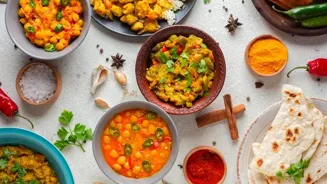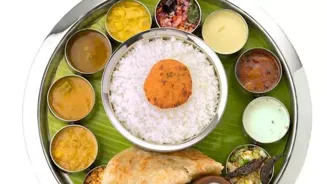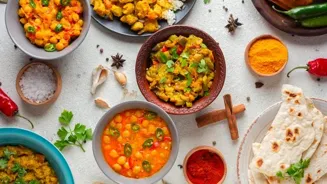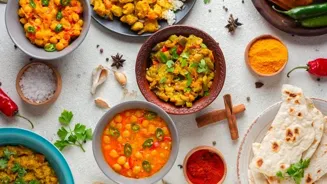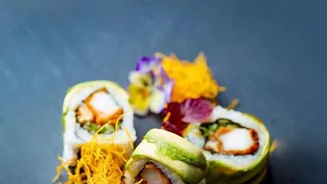Unveiling India's Spice Route: An Epic Journey into Culinary History. Dive deeper into the flavors that shaped a nation
India, a land known for its vibrant culture and diverse landscapes, also boasts a rich
culinary heritage deeply intertwined with the ancient Spice Route. This historic network of trade routes, connecting the East with the West, has shaped not only India's economy but also its gastronomic identity.
For centuries, spices like pepper, cardamom, cinnamon, and turmeric have been highly valued commodities, sought after for their flavor, medicinal properties, and preserving abilities.
These spices traveled across continents, carried by merchants, explorers, and adventurers, leaving an indelible mark on the cuisines and cultures they encountered.
Spice Route: Catalyst for Culinary Fusion & Diversity
The Spice Route wasn't just a means of transporting goods; it was a conduit for cultural exchange. As traders journeyed back and forth, they brought with them new ingredients, cooking techniques, and culinary traditions.
This constant interaction led to a fusion of flavors and culinary styles, enriching the Indian palate and contributing to the regional variations we see today. From the fiery curries of the South to the aromatic biryanis of the North, the influence of the Spice Route is evident in every bite.
Ancient spice trade from India to the West
The story of the Spice Route in India dates back thousands of years. The Indus Valley Civilization, one of the earliest urban societies, traded spices with Mesopotamia as early as the 3rd millennium BCE.
Archaeological evidence suggests that cloves, cinnamon, and ginger were among the spices that were exported from India to the West. During the Mauryan Empire, trade flourished, and spices became an integral part of the economy.
The Romans, known for their lavish banquets, craved Indian spices, which they used to enhance the flavor and preserve their food.
Demand for Indian spices drove maritime exploration and colonial conflicts
The demand for Indian spices fueled maritime exploration. European powers, eager to break the Arab monopoly on the spice trade, set out to find new sea routes to India. Vasco da Gama's arrival in Calicut in 1498 marked a turning point in the history of the Spice Route.
The Portuguese established trading posts along the Indian coast, followed by the Dutch, the French, and the British. The competition for control of the spice trade led to colonial conflicts and the eventual dominance of the British East India Company.
Colonial era shifts Spice Route with new crops, but spices remain vital in Indian culture
The colonial era brought about significant changes in the Spice Route. The British introduced new crops, such as tea and coffee, which gradually replaced spices as major export commodities. However, spices continued to play a vital role in Indian cuisine and culture.
The British also established spice plantations and introduced modern farming techniques, further shaping the landscape of the Indian spice industry.
Spices in Indian culture valued for medicinal benefits
Beyond their culinary uses, spices have long been valued in India for their medicinal properties. Ayurveda, the ancient Indian system of medicine, recognizes the therapeutic benefits of various spices. Turmeric, for example, is known for its anti-inflammatory and antioxidant properties.
Ginger is used to aid digestion and relieve nausea. Cardamom is believed to have antiseptic and expectorant qualities.
Spices in Indian medicine promote holistic health traditions
These medicinal benefits have been passed down through generations, and spices continue to be an essential part of traditional remedies. Many Indian households have a spice cabinet filled with ingredients that are used not only for cooking but also for treating common ailments.
The use of spices in medicine is a testament to the holistic approach to health that is deeply ingrained in Indian culture.
Spices in religious and cultural events create positivity
Spices also play a significant role in religious and cultural ceremonies. Turmeric, for instance, is considered auspicious and is used in weddings and other festive occasions. Saffron, a prized spice, is often used in religious offerings and sweets.
The aroma of spices is believed to create a positive and spiritual atmosphere.
India's diverse regional cuisines with unique spice blends
India's vast geography and diverse climate have given rise to a wide variety of regional cuisines, each with its unique blend of spices. In the South, spices like mustard seeds, curry leaves, and tamarind are used extensively.
Tamil Nadu, Kerala, Karnataka and Andhra Pradesh curries are known for their tangy and spicy flavors. The coastal regions of Kerala and Goa are famous for their seafood dishes, which are generously seasoned with local spices.
Regional Indian cuisines vary in flavors and spices
In the North, spices like cumin, coriander, and garam masala are prevalent. The cuisine of Punjab is known for its rich and creamy dishes, while Rajasthan offers a variety of spicy and flavorful lentil preparations.
In the East, the cuisine of Bengal is characterized by its use of mustard oil, panch phoron (a blend of five spices), and a touch of sweetness. The cuisine of Assam is known for its use of fermented ingredients and unique spices.
Indian culinary diversity shaped by local ingredients, climate, and spices
Each region's unique culinary identity has been shaped by its local ingredients, climate, and cultural influences. The use of spices varies from region to region, reflecting the diversity and richness of India's culinary heritage.
India's spice industry boosts economy through export
Today, India remains a major producer and exporter of spices. The Indian spice industry is a significant contributor to the country's economy, providing livelihoods for millions of farmers and workers.
The demand for Indian spices continues to grow, driven by the increasing popularity of Indian cuisine around the world.
Modern technology revolutionizes spice trade, enhancing quality and accessibility
Modern technology has transformed the spice trade. Spices are now processed, packaged, and transported using advanced techniques, ensuring quality and freshness.
Online platforms have made it easier for consumers to access a wide variety of Indian spices, connecting them directly with farmers and producers.
Challenges facing Indian spice industry: climate change, market prices, competition
However, the spice industry also faces challenges. Climate change, fluctuating market prices, and competition from other countries are some of the factors that affect the livelihoods of spice farmers.
Sustainable farming practices and fair trade initiatives are crucial for ensuring the long-term viability of the Indian spice industry.
Preserving India's spice heritage through sustainable farming and education
The Spice Route is more than just a historical trade network; it is a testament to India's rich culinary and cultural heritage. Preserving this legacy is essential for future generations.
Efforts are being made to promote sustainable spice farming, support local spice producers, and educate consumers about the importance of spices in Indian cuisine.
Culinary tourism preserves Spice Route, educates, supports communities
Culinary tourism is also playing a role in preserving the Spice Route's legacy. Food tours and cooking classes are becoming increasingly popular, allowing visitors to experience the flavors and aromas of Indian spices firsthand.
These experiences not only educate tourists about India's culinary heritage but also support local businesses and communities. The history is still being written and will continue to have meaningful connections and culinary implications.
